Tire Sidewall Cracking Chart: Check Out 4 Dangerous Conditions!
Have you been searching for tire sidewall cracking chart information but can’t find one? Well, no need to worry anymore. We have got you covered because we understand taking care of the tires is essential to avoid any serious accidents.
Read on to learn why these cracks happen and how to recognize 4 hidden symptoms. Also, get insights into crucial tips to take care of your tires. Following these simple steps can make your driving safer and keep your tires in good shape. Let’s dive into the details!
Table of Contents
Tire Sidewall Cracking – Is It Dangerous?
Driving with cracks in your tires is highly risky. Even though some people might consider it okay but it is not good advice. Those cracks get worse without you knowing, and that can become a big problem later on.
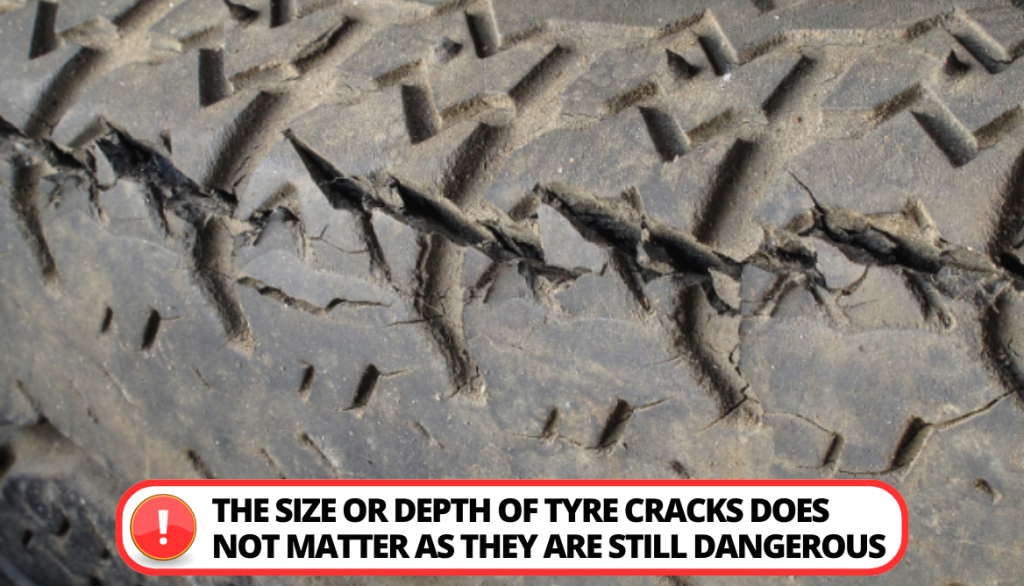
It is worth noting that the size or depth of the cracks doesn’t matter as they still are dangerous. Here are some key points about why tire cracking is a big deal:
- They weaken your tires, making tire sidewall unsafe to drive on.
- As the cracks get deeper, there’s a higher chance of the tire blowing out.
- Patching tires is a temporary solution and won’t stop the cracks from getting worse.
So, if any of the above cases happen to you, remember that:
- You should never ignore the cracks in the tires. Because they compromise the reliability of the tire and can result in accidents.
- It is not recommended to drive with cracked tires at all. Even if the cracks that seem minor can lead to sudden blowouts or loss of traction, putting you and others in danger.
- Cracked tires don’t have a larger lifespan. The only solution you have is to opt for a replacement. It is the best way to ensure your vehicle’s stability, handling, and overall performance on the road.
Now, with that, we will look at two cracking charts below that most likely happen.
1. Tire Sidewall Cracking Chart for Dry Rot
The sidewall tires cracking is a common problem that affects tires over time. Let’s learn the reason behind it.
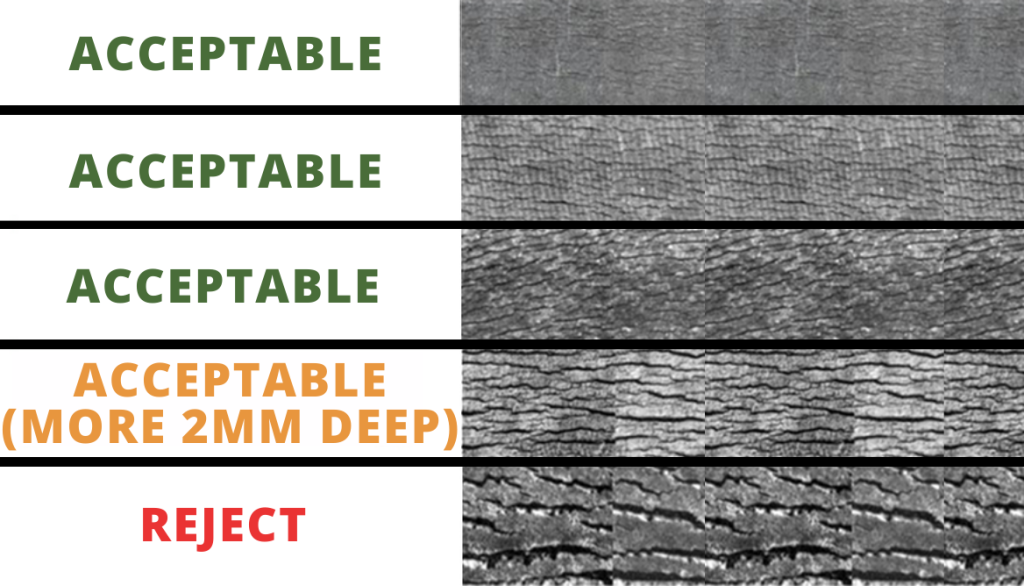
Why Does Dry Rot Happen?
Dry Rot mostly occurs when tires are exposed to harsh environmental conditions:
- Direct sunlight,
- Extreme temperatures,
- Damaging elements.
Understanding the Tires Cracking Chart
The chart displays various stages of sidewall cracking, ranging from mild to severe. It helps you assess the condition of the tires and determine if they need immediate replacement.
When to Take Action?
Driving with tire dry rot can be hazardous, as it increases the risk of tire blowouts or loss of control. If the tire sidewall exhibits signs of cracking, it is essential to take action promptly.
2. Chart for Michelin Sidewall Tire Cracking
The Michelin sidewall tire cracking chart is provided by the Michelin tire company itself. It aims to educate consumers about potential sidewall cracking issues.
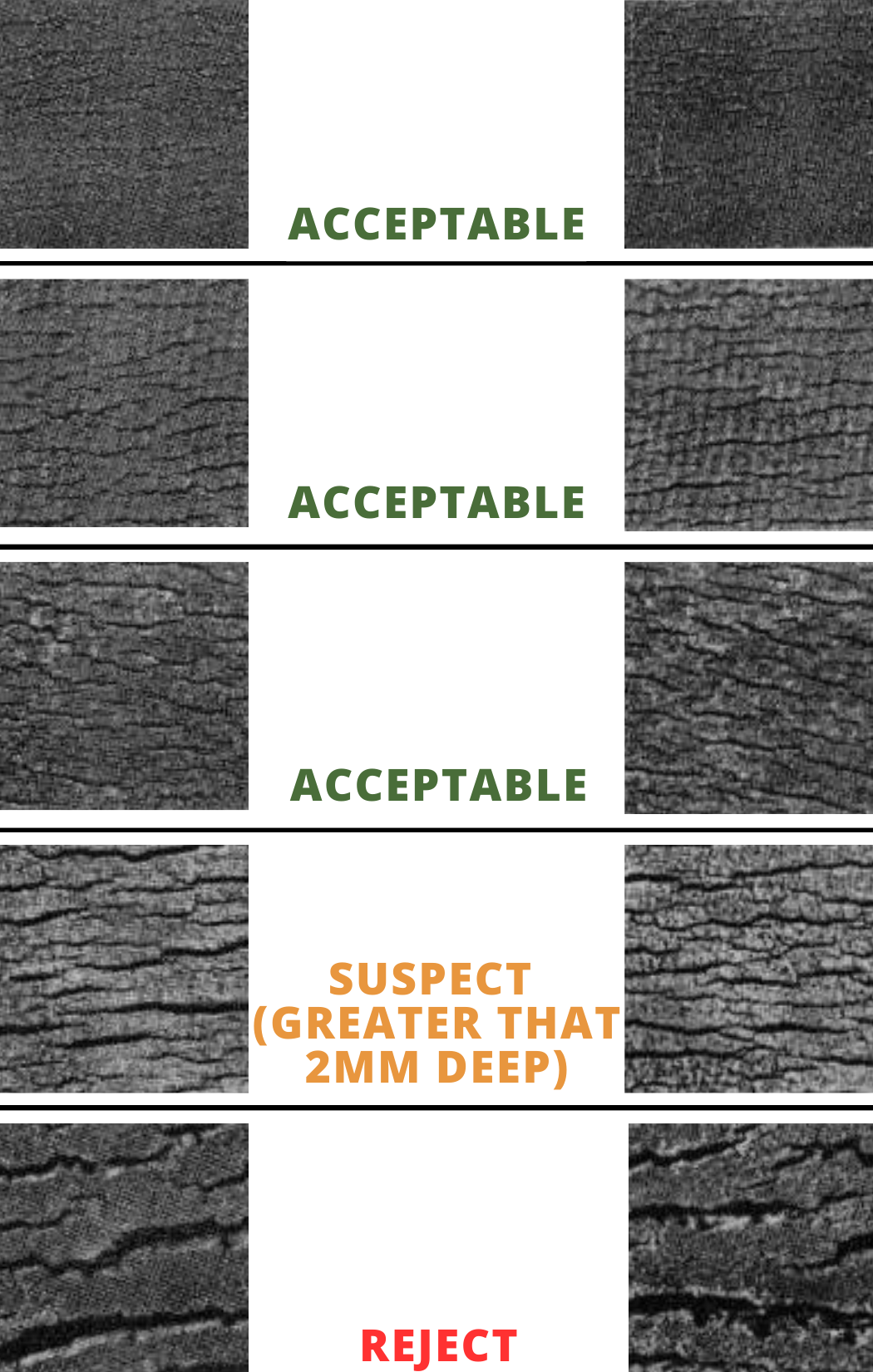
Why Do Sidewall Cracks Happen in Michelin Tires?
Sidewall cracks in Michelin tires, like in other brands, can result from various factors such as:
- Aging,
- Exposure to harsh conditions,
- Lack of maintenance.
Understanding the Tire Cracking Chart
This chart is designed by Michelin to illustrate the different types and levels of sidewall cracking that may occur in their tires. It can help you to understand the signs of sidewall cracking and whether the issue falls within an acceptable range or requires immediate attention.
When to Take Action
If a Michelin tire shows signs of sidewall cracks, it is advisable to consult this chart. With this, you can assess the severity of the cracks and determine the best course of action. This may involve tire replacement to ensure safe driving conditions.
2 Common Reasons Behind Tire Cracks: Understanding Sidewall and Tire Treads Issue
To understand the reasons behind small cracks in tires, it’s essential first to examine the factors that contribute to these cracking. Below we will be considering two factors, first on the sidewalls and then on the tire treads.
1. Intensive Sidewalls Issues
Sidewall cracks can occur due to various causes, such as:
- Humidity,
- Heat,
- Overloading,
- Impact Damage.
Improper tire maintenance and neglecting to keep tires properly inflated also plays a role in sidewall deterioration. Let’s explore these factors:
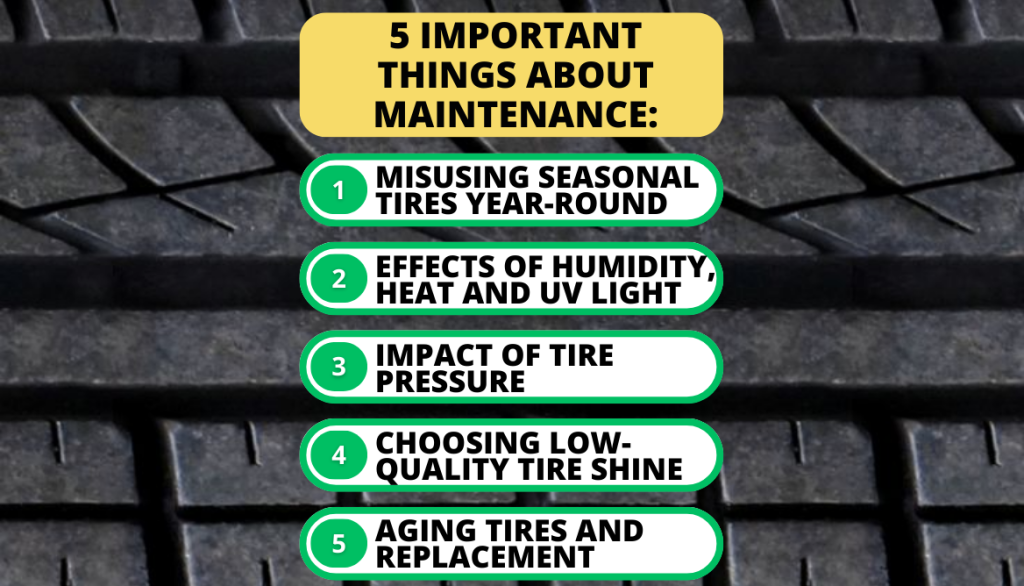
Misusing Seasonal Tires Year-Round
One common reason for tire cracks is the improper use of seasonal tires throughout the year. Rather than using them during their intended seasons.
- For instance, using summer tires in cold temperatures below 44 degrees F can cause them to harden. This leads to violent cracks on the tire sidewalls.
- Similarly, using winter tires on hot days can strain their structures, making them prone to cracks.
Effects of Humidity, Heat, and UV Light
Fluctuating temperatures can cause tire contraction and expansion, especially in substandard environments. It results in premature cracking.
- Tires with tiny cracks can allow water penetration, accelerating the breakdown process.
- Exposure to UV light is another critical factor as it can damage the tire rubber.
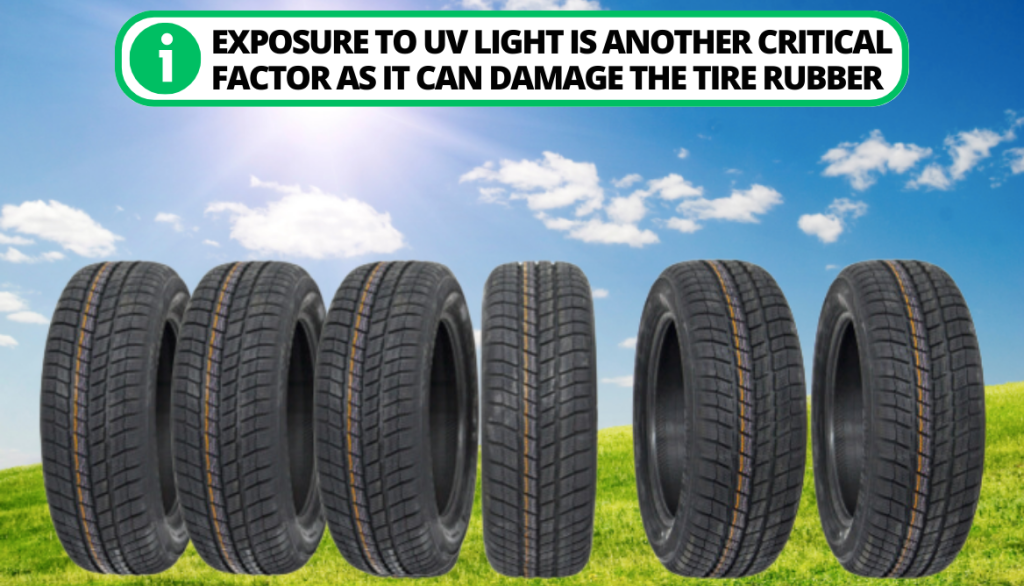
Impact of Tire Pressure
Proper tire inflation is vital to avoid tire cracks. Underinflated tires generate excess heat and undergo extreme expansion and contraction, leading to cracking. On the other hand, overinflated tires stretch the tire’s inner compounds, increasing the risk of:
- Cracking;
- Bulging;
- Blowouts.
Choosing Low-Quality Tire Shine
Using low-quality tire-shining products leads to tire cracks:
- Some products may increase tire dry rot or contain harsh chemicals that damage the rubber.
- High-quality tire-shining products help protect the tires and slow the cracking process.
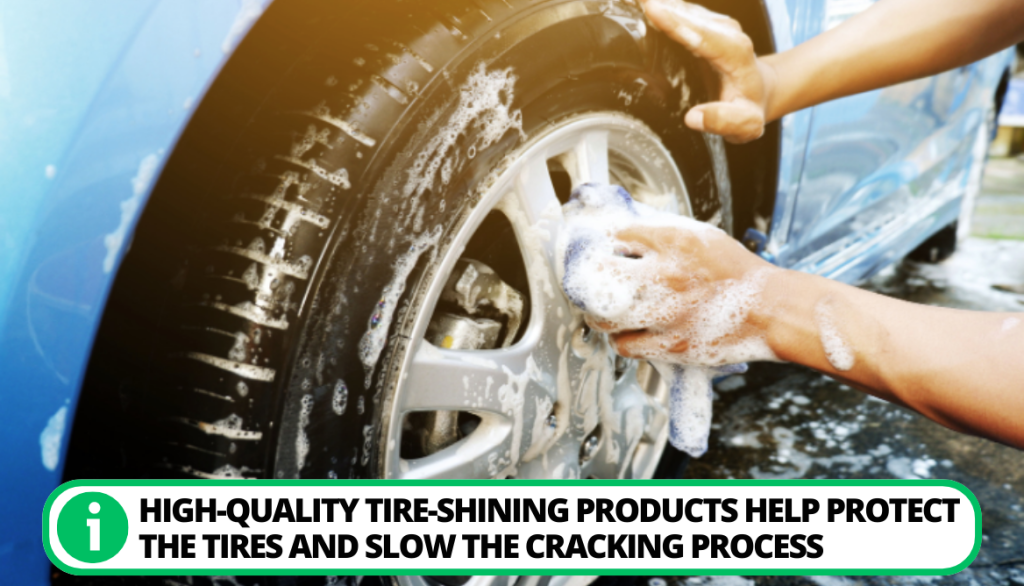
Aging Tires and the Importance of Replacement
Car tires have a limited lifespan, and as they age, they become more susceptible to cracking and other forms of deterioration. Even with proper maintenance, tires will eventually reach a point where they need replacement. It is crucial to pay attention to the sidewalls for developing cracks and have the cracked tires replaced promptly.
2. Cracks Occurring on the Tire Tread
Tread cracks in tires are not common, but they can be very risky. They appear on tires due to factors like:

- Aging;
- Exposure to harsh weather conditions;
- Improper maintenance.
These cracks start on the tire’s sides and can move to the tread, the part that touches the road. If left untreated, they could lead to reduced traction and ultimately accidents.
Understanding the 4 Hidden Symptoms for Cracked Tires
Within the appearance of weather-cracked tires are the signs of potential danger. These hidden symptoms can include fine lines and fissures on the tire surface, often concealed amidst the tire’s tread patterns.
By recognizing these signs, you can take timely action to address potential issues and prevent further damage. Let’s take an in-depth look:
1. Brittle Texture in Tire Rubber
One of the prominent signs of cracked tires is the development of brittleness in the tire rubber.
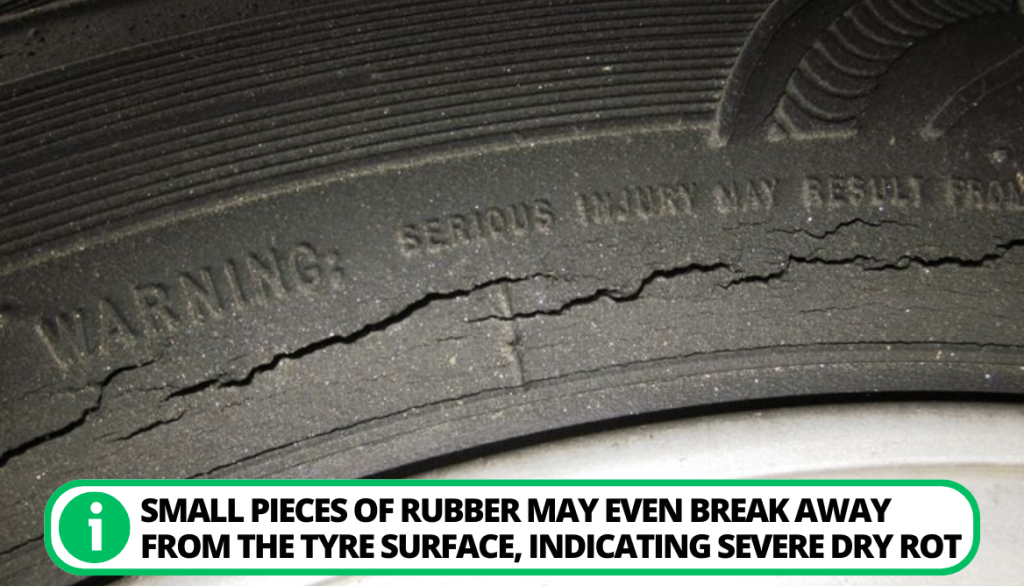
- Dry rot causes the tires to lose their essential oils, making them more apparent to cracking.
- The tires may feel stiff and rigid when touched.
- In some cases, small rubber pieces may even break off from the surface of the tire, indicating severe tire dry rot.
2. Tears Affecting Tires
Whether the dry rot is mild or severe, you’ll notice visible tears or cracks along the sidewall of the tire. These cracks may appear as small lines and can extend to cover larger areas near the hubcap. The severity of these visible tears may vary depending on the extent of dry rot and the tire’s age.
3. Treaded Cracks
Advanced sidewall cracks also affect the tire tread which can be noticed on particularly the outer edge. The presence of tread cracks makes it challenging to control the car properly.
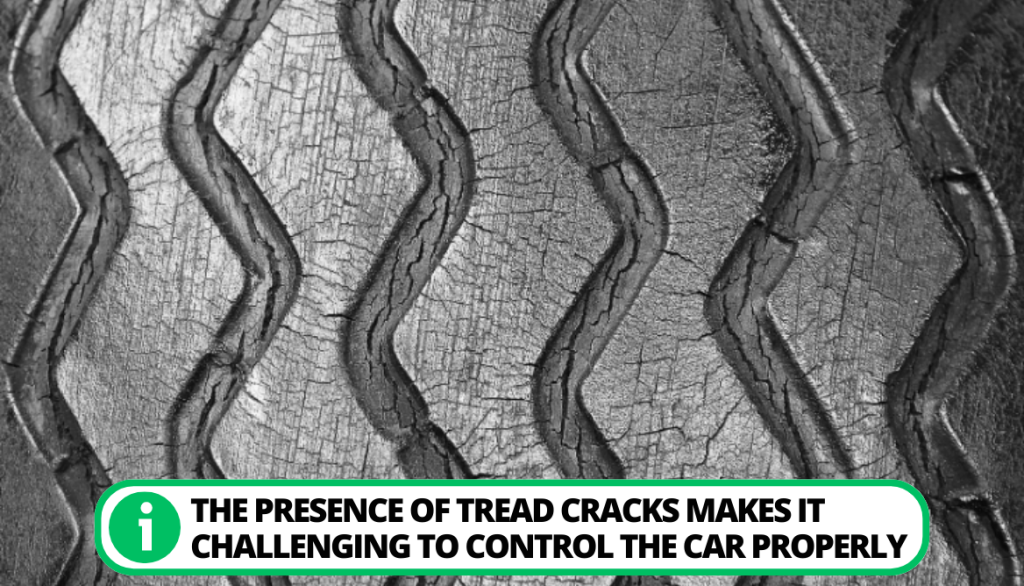
4. Changes in Tire Color Appearance
Another indicator of tire cracks is a change in the tire’s color.
- If you observe that your tire starts to look greyer instead of its original black color, it may be a sign of dry rot and cracking.
- The fading of the tire’s color often accompanies the development of cracks, and these issues can get worse over time.
3 Handy Tips to Check Tire Expiration Date to Ensure Safety
Taking just a minute to inspect your tires can reveal crucial information about their age and condition. This will, however, ensure a safer driving experience. Below is a step-by-step guide to help you check your tires’ expiration date:
1. Have a Close Look at Your RV Tire
Examine your tires closely to look for signs of aging, such as visible cracks or dry rot. If your tires show these symptoms, it’s a clear indication that they might be old. Remember that even if your tires appear to be in good shape, any tire that is six years old or more should be replaced with a new set to maintain optimal safety.
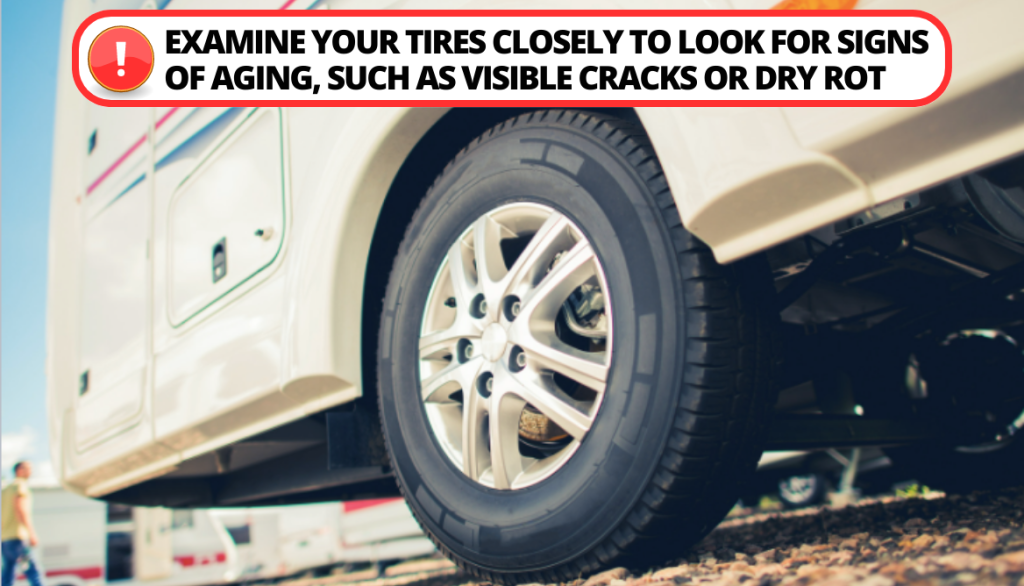
2. Check the Tires’ Sidewall Especially
On the sidewall of your tire, you will find the letters “DOT.” This indicates that the tire manufacturer adheres to the safety standards. These are set by the U.S. Department of Transportation (DOT) and the National Highway Traffic Safety Administration (NHTSA). Inspecting the sidewall is the first step in determining your tires’ age.
3. Find Tire Manufacturers Year
After the “DOT” letter, you’ll see a series of letters and numbers. Among these, focus on the last two numbers. These two digits represent the year your tires were manufactured. For instance, if the numbers are “20,” it means the tire was made in 2020, “15” indicates 2015, and “10” denotes 2010. Driving on a tire that is ten years old or more is extremely risky.

FAQ
How much cracking in tires is ok?
Shallow surface cracking is generally acceptable, but deep or extensive cracks, especially in the sidewalls or across the tread, indicate potential risks and the best course of action will be tire replacement.
Are tires with cracked sidewalls safe?
No, tires with cracked sidewalls are not considered safe. They pose significant risks and should not be used for driving as they can lead to dangerous situations, including tire blowouts.
Why do tire sidewalls crack?
The tire sidewalls crack due to various factors including overloading, aging, and UV exposure.
Are cracks in tires normal?
Yes, cracking in tires can happen over time. But, the deep cracks are not considered safe. As the rubber loses its flexibility, cracks begin to form which can result in accidents.
Can you stop the tires from cracking?
Yes, you can stop the tires from cracking up to a certain extent. You can minimize it by regularly maintaining proper tire inflation, avoiding overloading, and storing tires in a cool dry place away from sunlight.
Conclusion
Summing it up, sidewall tire cracking is a common problem that poses risks to your driving safety. According to the cracking chart, you should limit driving or replace the tires if you see any cracks in the sidewall or dry rot that is deeper than 2mm.
As per DOT and NHTSA instructions, don’t use tires that are older than ten years. Moreover, regular inspection of your tires, maintaining proper inflation, and avoiding extreme temperatures prevent cracking and ensure a smoother journey.
Have you noticed any sidewall cracks on your car’s tires and what methods did you use to fix them? Share your experience in the comments!

I`m a current Law Enforcement Officer working within the Counterterrorism Bureau in New York State. I have been Camping for over 20 years. My styles of camping include tent, car, truck, van, and RV travel trailer. I have a YouTube channel where I teach all types of camping with an entertaining method: https://youtube.com/@TheSmallsRVAdventures






